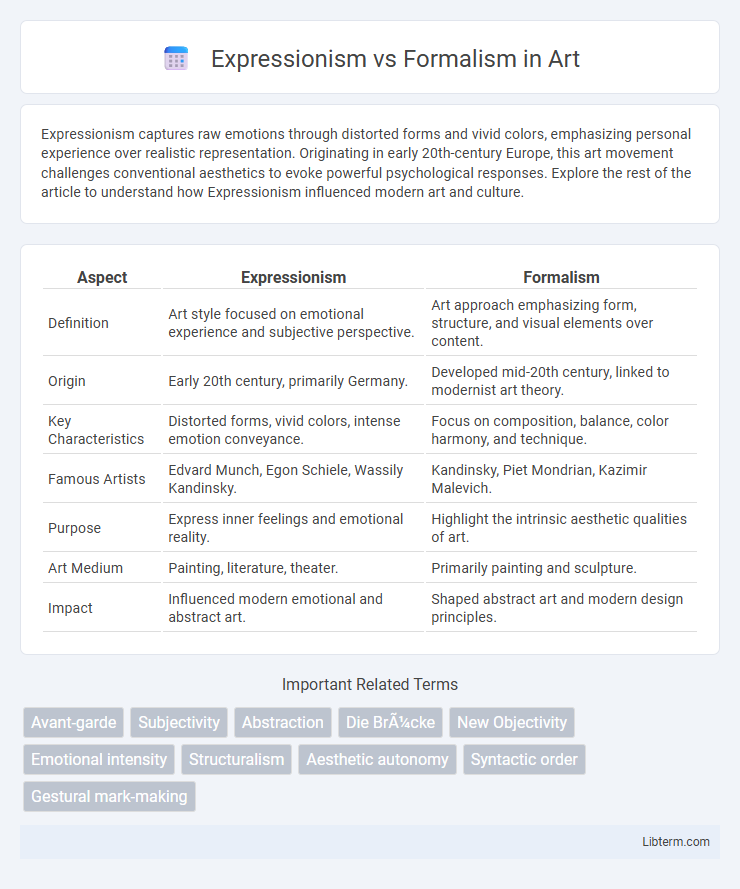Expressionism captures raw emotions through distorted forms and vivid colors, emphasizing personal experience over realistic representation. Originating in early 20th-century Europe, this art movement challenges conventional aesthetics to evoke powerful psychological responses. Explore the rest of the article to understand how Expressionism influenced modern art and culture.
Table of Comparison
| Aspect | Expressionism | Formalism |
|---|---|---|
| Definition | Art style focused on emotional experience and subjective perspective. | Art approach emphasizing form, structure, and visual elements over content. |
| Origin | Early 20th century, primarily Germany. | Developed mid-20th century, linked to modernist art theory. |
| Key Characteristics | Distorted forms, vivid colors, intense emotion conveyance. | Focus on composition, balance, color harmony, and technique. |
| Famous Artists | Edvard Munch, Egon Schiele, Wassily Kandinsky. | Kandinsky, Piet Mondrian, Kazimir Malevich. |
| Purpose | Express inner feelings and emotional reality. | Highlight the intrinsic aesthetic qualities of art. |
| Art Medium | Painting, literature, theater. | Primarily painting and sculpture. |
| Impact | Influenced modern emotional and abstract art. | Shaped abstract art and modern design principles. |
Introduction to Expressionism and Formalism
Expressionism emphasizes personal emotions and subjective experience, highlighting vivid colors, distorted forms, and dynamic compositions to evoke intense feelings. Formalism concentrates on the formal elements of art--such as line, shape, color, and composition--prioritizing structure and aesthetic order over narrative or emotional content. These distinct approaches shape how artworks are analyzed, either through emotional impact or through their formal qualities and design principles.
Historical Origins and Development
Expressionism originated in early 20th-century Germany as a reaction against realism, emphasizing emotional experience and individual perspective in art, literature, and theater. Formalism emerged concurrently, particularly in Russia and later in Western art criticism, prioritizing structural elements, form, and technique over content or emotional expression. Both movements significantly shaped modernist aesthetics, with Expressionism influencing avant-garde movements and Formalism laying the groundwork for structural analysis in art and literature.
Key Philosophical Foundations
Expressionism centers on conveying subjective emotions and individual experience, emphasizing authenticity and personal interpretation in art. Formalism prioritizes the intrinsic elements of artwork such as form, color, structure, and composition, advocating for aesthetic value independent of emotional or narrative content. The key philosophical foundation of Expressionism is rooted in existentialism and emotional truth, while Formalism draws from structuralism and aesthetic autonomy principles.
Major Artists and Influencers
Expressionism features major artists such as Edvard Munch, Egon Schiele, and Ernst Ludwig Kirchner, who emphasized emotional intensity through vivid colors and distorted forms. Formalism is championed by figures like Clement Greenberg and artists including Kazimir Malevich and Piet Mondrian, prioritizing form, structure, and the medium's inherent qualities over emotional content. Both movements significantly influenced modern art, with Expressionism focusing on subjective experience and Formalism on aesthetic purity and composition.
Visual and Stylistic Differences
Expressionism emphasizes emotional experience through exaggerated colors, distorted forms, and dynamic brushstrokes, creating intense, subjective visuals that evoke psychological depth. Formalism prioritizes compositional elements like shape, line, color, and balance, focusing on structure and aesthetic harmony without necessarily conveying emotional narratives. Visual distinctions include Expressionism's chaotic, vibrant imagery versus Formalism's clean, orderly arrangements highlighting artistic technique and design principles.
Techniques and Materials Used
Expressionism emphasizes raw, emotive brushwork and vivid, often distorted imagery using oil paints, acrylics, and mixed media to convey intense personal feelings. Formalism prioritizes structured compositions, precise lines, and balanced forms achieved through controlled techniques like geometric arrangements and traditional media such as graphite, charcoal, and tempera. Both movements explore contrasting approaches: Expressionism relies on spontaneous, textured surfaces, while Formalism focuses on clarity, order, and harmony in visual presentation.
Thematic Focus and Intentions
Expressionism emphasizes the exploration of emotional experience and subjective interpretation, aiming to evoke intense feelings and internal states through distortion and abstraction. Formalism prioritizes the structural elements of art, such as composition, color, and form, focusing on aesthetic qualities rather than emotional or narrative content. Expressionist works often address themes of human angst and alienation, while Formalist art seeks to achieve visual harmony and intellectual engagement through formal techniques.
Critical Reception and Impact
Expressionism garnered critical acclaim for its emotional intensity and subjective representation, profoundly influencing early 20th-century art, literature, and theater by championing personal experience over realistic depiction. Formalism attracted praise for its analytical approach, emphasizing the intrinsic elements of art such as composition, color, and form, which shaped modernist and contemporary art criticism and theory. Both movements spurred debates on artistic value, with Expressionism prioritizing emotional depth and Formalism advocating for structural integrity, impacting diverse creative practices and scholarly discourse.
Modern Interpretations and Legacy
Modern interpretations of Expressionism emphasize emotional intensity and subjective experience, highlighting artists like Edvard Munch and Egon Schiele, whose works challenge traditional aesthetics through bold color and dynamic forms. Formalism, championed by critics such as Clement Greenberg, prioritizes purity of form and medium-specific qualities, influencing abstract movements and minimalism by focusing on visual elements rather than narrative content. The legacy of Expressionism persists in contemporary art's exploration of psychological depth, while Formalism's rigorous attention to structure continues to shape critical discourse and artistic practices in modern and postmodern contexts.
Choosing Between Expressionism and Formalism
Choosing between Expressionism and Formalism depends on the artistic intent and emphasis: Expressionism prioritizes emotional impact, subjective experience, and the conveyance of inner feelings through distortion and vivid colors, while Formalism concentrates on structural elements, composition, and the intrinsic qualities of art such as line, shape, and color. Artists leaning toward personal emotion and psychological depth might prefer Expressionism to evoke strong viewer responses. Conversely, those interested in technique, balance, and aesthetic harmony often select Formalism to highlight craftsmanship and visual order.
Expressionism Infographic

 libterm.com
libterm.com